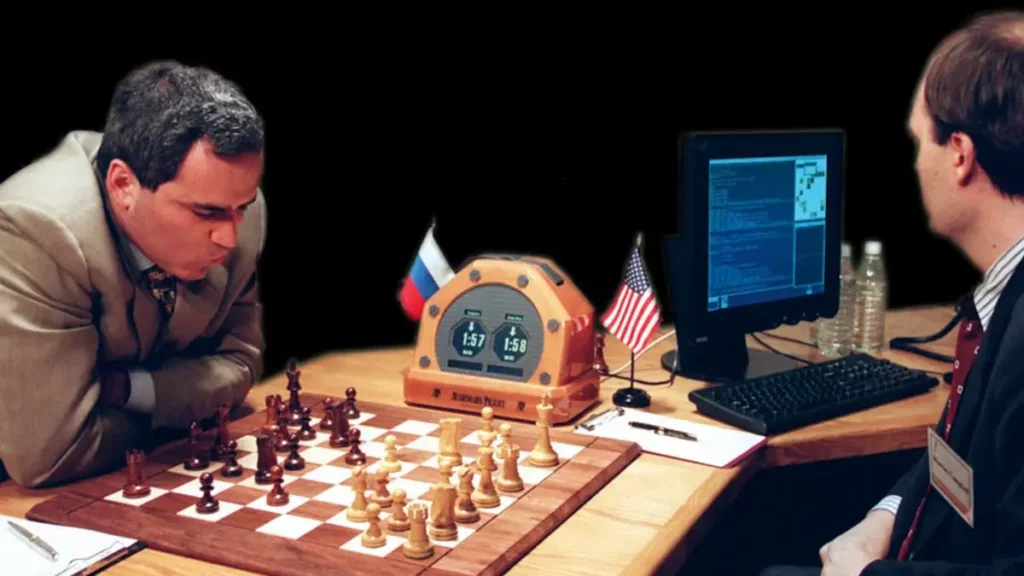A game of chess is so complex that it posed a major challenge for artificial intelligence. To accomplish the feat of defeating the world champion, IBM harnessed significant resources…
This compelling story became the focus of a mini-series, Rematch, which aired on Arte. The suspense surrounding these epic battles was vividly portrayed by the series, which recounts the historic triumph of a machine over a human during the final match of the Deep Blue computer against Garry Kasparov on May 11, 1997.
The Deep Blue Project
Feng-hsiung Hsu began developing a supercomputer capable of playing chess during his doctoral studies at Carnegie Mellon University. After earning his doctorate in 1989, Hsu was recruited by IBM Research to continue his work. His mission: to eventually defeat the world chess champion. The computer developed by Hsu and his team was named Deep Blue. To train the computer effectively, IBM brought in several chess masters, including Joel Benjamin, the American champion in the field.

Defeated by Garry Kasparov
In 1996, from February 10th to 16th, the Deep Blue computer faced the Russian chess champion Garry Kasparov for the first time in Philadelphia. The match conditions allowed each player two hours for the first 40 moves.
That year, IBM’s computer won the first game, but the world champion quickly regained control. With a final score of 4 to 2, Kasparov decisively defeated Deep Blue.
Within IBM, there was significant disappointment, coupled with a strong desire to arrange a rematch. The computing giant needed to restore its reputation after a series of setbacks that had caused its stock price to drop.
Initially, Kasparov declined the rematch offer but was later tempted. IBM offered substantial financial compensation, and Kasparov wanted to prove that he could defeat an improved version of Deep Blue, thereby showcasing human intelligence as superior to artificial intelligence.
The 1997 Rematch
For over a year, IBM engineers enhanced Deep Blue, reaching a point where the supercomputer, equipped with 30 processors operating in parallel and supported by 480 dedicated chess chips, could evaluate 200 million possible moves per second.
The first match of the new series of encounters took place on May 3, 1997, in New York. However, in the initial match, to the great surprise of IBM, Kasparov won decisively.
The following day, during the 2nd game, Deep Blue’s 11th move threw Kasparov off balance, and he struggled to regain his composure. In the end, the Russian player conceded the game. It turned out he could have managed a draw if he had persisted.
Kasparov Accuses IBM of Cheating
This led to heightened tension on both sides. During the next three games, the tension reached its peak, particularly as each resulted in a draw. Nevertheless, Kasparov, who considered himself unbeatable, felt his confidence waver. He even went so far as to accuse IBM of cheating and having human players intervene in secret.

Deep Blue Outplays Kasparov's Tactics
On May 11, during the final encounter, Kasparov tried to confound Deep Blue with multiple unexpected moves. However, on the 7th move, the world champion attempted a tactic that failed, allowing Deep Blue to gradually weaken its opponent. IBM’s computer eventually emerged victorious.
With a score of 3.5 to 2.5, Deep Blue concluded as the winner, and the news sent shockwaves worldwide.
A Breakthrough in Artificial Intelligence?
Yet, Deep Blue’s success did not signify the feats of a thinking machine but was rather achieved through what was described as “brute force” – computational power so vast that it could analyze an enormous number of possible moves to decide the best one. The pinnacle of AI was still to come.










